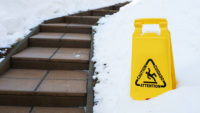Eye on Safety: Steps to take for fall prevention
Ladder safety at work

naveebird / iStock / Getty Images Plus via Getty Images
In this article we are going to discuss ladder safety. However, before touching on using ladders themselves, first we must ensure the housekeeping of the area in which the work will be conducted is maintained in adequate form — as with any on-the-job-project.
When utilizing a ladder, first ensure general housekeeping is in effect and maintained and nothing will be in the way of performing your work or result in you creating a shortcut to ensuring your safety. Scan the environment and be aware of potential external interference with safe use of your ladder during work. That is, ensure an environment free from debris or other hazards that could cause slips, trips and falls.
Speaking of falls, that is the main danger that we are looking out for in ladder usage. After all, the process of climbing the ladder is not an easy feat, considering that your body is not positioned on a secured surface, and you are raised above the surface. People have died from serious falls arising from ladders. OSHA reports that falls are the leading cause of death in construction, and that every year falls from ladders make up nearly a third of those deaths. These deaths are preventable. Falls from ladders can be prevented and lives can be saved by following the safe work practices outlined by OSHA.
Also, be sure to ask yourself these questions before deciding on a ladder:
- Will I have to hold heavy items while on the ladder?
- Is the elevated area high enough that it would require a long ladder that can be unstable?
- Will I be working from this height for a long time?
- Do I have to stand on the ladder sideways in order to do this work?
If your answer is yes to any of the above questions, consider using something other than a ladder. If possible, bring in other equipment like a scissor lift. If you have to use a ladder, use one that has a working platform with handrail barricades on the sides (e.g., a platform stepladder).
Before you use any ladder, you should inspect the ladder to ensure it appears to be in standard working order, including that it is not bent or has any noticeable concerns that would cause it to not perform to standards. Think of this as a “pre-use ladder inspection”. Any issues should be addressed and if equipment is not in good working order, do not use it.
With ladders, the general rule is to always maintain three points of contact. What does this mean?
You have four limbs (two hands and two feet), so ideally, you want to have a combination of three points of contact at any point until you are on the ground or in an area where it is safe to do so.
Follow these steps when utilizing a ladder:
- Position the ladder and ensure it is secured. There are several ways to secure a ladder, but a ladder has a top and a bottom. If using an extension ladder, you will want to secure the base and the top. On the other hand, a step ladder, essentially has “two bases”, so the top would not be secured, in the same sense.
- Keep your body centered when climbing (do not lean and of course, do not over-extend or reach to break your contact).
- Face forward when you climb, do not go up sideways or backwards.
- Depending on the height, if you cannot hold on to ladder with at least one hand, a safety harness should be explored.
- OSHA refers to firm grasp rule and recommends tools and other essentials be put in a safety belt. By firm grasp, OSHA requires at least one hand to grasp the ladder when climbing up and down (which is not limited to the horizontal rungs).
SUMMARY
Utilize three points of contact, and where not available, fall protection should be utilized. It is easy to try to move too quickly and do things in a rush, where rushing creates a higher probability that an event will occur. The event can cause serious damage and falls do result in worker fatalities. Let’s ensure you and your employees can return to their families each night and take the necessary precaution so as not become a part of that statistic.
Please consult your safety professional for further clarifications and many insurance companies have safety resources at your disposal.
Looking for a reprint of this article?
From high-res PDFs to custom plaques, order your copy today!






